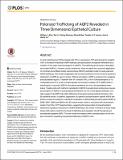| dc.contributor.author | Rice, William L. | en_US |
| dc.contributor.author | Li, Wei | en_US |
| dc.contributor.author | Mamuya, Fahmy | en_US |
| dc.contributor.author | McKee, Mary | en_US |
| dc.contributor.author | Păunescu, Teodor G. | en_US |
| dc.contributor.author | Lu, Hua A. Jenny | en_US |
| dc.date.accessioned | 2015-08-03T14:01:53Z | |
| dc.date.issued | 2015 | en_US |
| dc.identifier.citation | Rice, William L., Wei Li, Fahmy Mamuya, Mary McKee, Teodor G. Păunescu, and Hua A. Jenny Lu. 2015. “Polarized Trafficking of AQP2 Revealed in Three Dimensional Epithelial Culture.” PLoS ONE 10 (7): e0131719. doi:10.1371/journal.pone.0131719. http://dx.doi.org/10.1371/journal.pone.0131719. | en |
| dc.identifier.issn | 1932-6203 | en |
| dc.identifier.uri | http://nrs.harvard.edu/urn-3:HUL.InstRepos:17820813 | |
| dc.description.abstract | In renal collecting duct (CD) principal cells (PCs), vasopressin (VP) acts through its receptor, V2R, to increase intracellular cAMP leading to phosphorylation and apical membrane accumulation of the water channel aquaporin 2 (AQP2). The trafficking and function of basolaterally located AQP2 is, however, poorly understood. Here we report the successful application of a 3-dimensional Madin-Darby canine kidney (MDCK) epithelial model to study polarized AQP2 trafficking. This model recapitulates the luminal architecture of the CD and bi-polarized distribution of AQP2 as seen in kidney. Without stimulation, AQP2 is located in the subapical and basolateral regions. Treatment with VP, forskolin (FK), or 8-(4-Chlorophenylthio)-2′-O-methyladenosine 3′,5′-cyclic monophosphate monosodium hydrate (CPT-cAMP) leads to translocation of cytosolic AQP2 to the apical membrane, but not to the basolateral membrane. Treating cells with methyl-β-cyclodextrin (mβCD) to acutely block endocytosis causes accumulation of AQP2 on the basolateral membrane, but not on the apical membrane. Our data suggest that AQP2 may traffic differently at the apical and basolateral domains in this 3D epithelial model. In addition, application of a panel of phosphorylation specific AQP2 antibodies reveals the polarized, subcellular localization of differentially phosphorylated AQP2 at S256, S261, S264 and S269 in the 3D culture model, which is consistent with observations made in the CDs of VP treated animals, suggesting the preservation of phosphorylation dependent regulatory mechanism of AQP2 trafficking in this model. Therefore we have established a 3D culture model for the study of trafficking and regulation of both the apical and basolaterally targeted AQP2. The new model will enable further characterization of the complex mechanism regulating bi-polarized trafficking of AQP2 in vitro. | en |
| dc.language.iso | en_US | en |
| dc.publisher | Public Library of Science | en |
| dc.relation.isversionof | doi:10.1371/journal.pone.0131719 | en |
| dc.relation.hasversion | http://www.ncbi.nlm.nih.gov/pmc/articles/PMC4493001/pdf/ | en |
| dash.license | LAA | en_US |
| dc.title | Polarized Trafficking of AQP2 Revealed in Three Dimensional Epithelial Culture | en |
| dc.type | Journal Article | en_US |
| dc.description.version | Version of Record | en |
| dc.relation.journal | PLoS ONE | en |
| dash.depositing.author | Rice, William L. | en_US |
| dc.date.available | 2015-08-03T14:01:53Z | |
| dc.identifier.doi | 10.1371/journal.pone.0131719 | * |
| dash.contributor.affiliated | Mamuya, Fahmy | |
| dash.contributor.affiliated | Rice, William | |
| dash.contributor.affiliated | Paunescu, Teodor | |
| dash.contributor.affiliated | Lu, Hua | |
| dash.contributor.affiliated | Li, Wei | |


